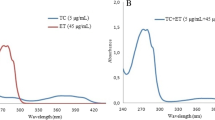Abstract
A flow-injection chemiluminescence (CL) method is described for the determination of ciprofloxacin (CIP), norfloxacin (NOR) and ofloxacin (OFL), commonly used antibiotics of the fluoroquinolones family. The method is based on the CL reaction of the fluoroquinolones with tris(2,2′-bipyridyl) ruthenium(II) and Ce (IV), in sulfuric acid medium. The maximum CL emission, given at 0.45 min for CIP, at 0.35 min for NOR and at 0.04 min for OFL, respectively, were measured, allowing the simple application of the proposed method to the routine analysis of the antibiotics. The methods were applied to the determination of CIP, NOR and OFL, in several pharmaceutical preparations, with very satisfactory results, and validated by a previously reported HPLC method. The time-resolved equipment allowed the measurement of the kinetic evolution of the chemiluminescence signals. In base to the differences in the kinetic behaviour of ofloxacin with respect to ciprofloxacin and norfloxacin, binary mixtures of the drugs were resolved by using the time-resolved chemiluminescence signals, in combination with first-order partial least-squares (PLS) multivariate calibration.






Similar content being viewed by others
References
Delgado JN (1991) Wilson and Gisvold’s textbook of organic medicinal and pharmaceutical chemistry. Lippincott-Raven, Philadelphia, US, p 155
Jackson LC, Machado LA, Hamilton ML (1998) Principios Generales de la terapéutica antimicrobiana. Acta Med 8:13–27
Mandell LA, Peterson LR, Wise R, Hooper D, Low DE, Shaad UB, Klugman KP, Courvalin P (2002) The battle against emerging antibiotic resistance: should fluoroquinolones be used in children? Clin Infect Dis 35:721–727
Sweetman S (2002) Martindale: the complete drug reference. The Pharmaceutical Press, Chicago, US, p 182
McEvoy GK (ed) (1995) Drug information. American Society of Health-System Pharmacists, p 493
Micromedex. Thomson MICROMEDEX(R) (2002) Healthcare Series, vol 116, DE0858
Ballesteros O, Toro I, Sanz-Nebot V, Navalón A, Vílchez JL, Barbosa J (2003) Determination of fluoroquinolones in human urine by liquid chromatography coupled to pneumatically assisted electrospray ionization mass spectrometry. J Chromatogr B 798:137–144
Vílchez JL, Ballesteros O, Taoufiki J, Sánchez-Palencia G, Navalón A (2001) Determination of the antibacterial norfloxacin in human urine and serum samples by solid-phase spectrofluorimetry. Anal Chim Acta 444:279–286
Rahman N, Ahmad Y, Hejaz Azmi SN (2004) Determination of norfloxacin by flow-injection chemiluminescence. J Pharm Biopharm 57:359–363
Sato K, Matsuura U, Inone M, Ueno T, Osada Y, Ogawa H, Mitshuhashi M (1982) In vitro and in vivo activity of DL-8280, a new oxazine derivative. Antimicrob Agents Chemother 22:548–553
Ichihara N, Tachizawa H, Tusumura M, Une T, Sato K (1984) Phase I study on DL-8280. Chemotherapy 32:118–149
Carlucci G (1998) Analysis of fluoroquinolones in biological fluids by high-performance liquid chromatography. J Chromatogr A 812:343–367
Kamberi M, Tsutsumi K, Kotegawa T, Nakamura K, Nakano KS (1998) Determination of ciprofloxacin in plasma and urine by HPLC with ultraviolet detection. Clin Chem 44:1251–1255
Maya MT, Goncalves NJ, Silva NB, Morais JA (2001) Simple high-performance liquid chromatographic assay for the determination of ciprofloxacin in human plasma with ultraviolet detection. J Chromatogr B 755:305–309
Wright DH, Herman VK, Konstantinides FN, Rotschafer JC (2000) Comparative pharmacodynamics of three newer fluoroquinolones versus six strains of staphylococci in an in vitro model under aerobic and anaerobic conditions. J Chromatogr B 709:97–104
Cohen E, Maxwell RJ, Donoghue DJ (1999) Automated multi-residue isolation of fluoroquinolone antimicrobials from fortified and incurred chicken liver using on-line microdialysis and high performance liquid chromatography with programmable fluorescence detection. J Chromatogr B 724:137–145
Yorke JC, Froc P (2000) Quantitation of nine quinolones in chicken tissues by high-performance liquid chromatography with fluorescence detection. J Chromatogr A 882:63–77
Holtzapple CK, Buckley SA, Stanker LH (2001) Determination of fluoroquinolones in serum using an on-line clean-up column coupled to high-performance immunoaffinity-reversed-phase liquid chromatography. J Chromatogr B 754:1–9
Golet EM, Alder AC, Hartmann A, Ternes TA, Giger W (2001) Trace determination of fluoroquinolone antibacterial agents in urban wastewater by solid-phase extraction and liquid chromatography with fluorescence detection. Anal Chem 73:3632–3638
Zotou A, Miltiadou N (2002) Sensitive LC determination of ciprofloxacin in pharmaceutical preparations and biological fluids with fluorescence detection. J Pharm Biomed Anal 28:559–568
El Walily AF, Belal SF, Bakry RS (1996) Spectrophotometric and spectrofluorimetric estimation of ciprofloxacin and norfloxacin by ternary complex formation with eosin and palladium(II). J Pharm Biomed Anal 14:561–569
Nagaralli BS, Seetharamappa J, Melwanki MB (2002) Sensitive spectrophotometric methods for the determination of amoxycillin, ciprofloxacin and piroxicam in pure and pharmaceutical formulations. J Pharm Biomed Anal 29:859–864
Mostafa S, El-Sadek M, Alla EA (2002) Spectrophotometric determination of ciprofloxacin, enrofloxacin and pefloxacin through charge transfer complex formation. J Pharm Biomed Anal 27:133–142
Rizk M, Belal F, Ibrahim F, Ahmed S, Sheribah ZA (2001) Derivative spectrophotometric analysis of 4-quinolone antibacterials in formulations and spiked biological fluids by their Cu(II) complexes. J AOAC Int 84:368–375
Navalon A, Ballesteros O, Blanc R, Vílchez JL (2000) Determination of ciprofloxacin in human urine and serum by solid-phase spectrofluorimetry. Talanta 52:845–852
Hernández M, Aguilar M, Borrull F, Calull M (2002) Determination of ciprofloxacin, enrofloxacin and flumequine in pig plasma samples by capillary isotachophoresis–capillary zone electrophoresis. J Chromatogr B 772:163–172
Fierens C, Hillaert S, Van den Bossche W (2000) The qualitative and quantitative determination of quinolones of first and second generation by capillary electrophoresis. J Pharm Biomed Anal 22:763–772
Schmitt-Kopplin P, Burhenne J, Freitag D, Spiteller M, Kettrup A (1999) Development of capillary electrophoresis methods for the analysis of fluoroquinolones and application to the study of the influence of humic substances on their photodegradation in aqueous phase. J Chromatogr A 837:253–265
Barron D, Jiménez-Lozano E, Cano J, Barbosa J (2001) Determination of residues of enrofloxacin and its metabolite ciprofloxacin in biological materials by capillary electrophoresis. J Chromatogr B 759:73–79
Snitkoff GG, Grabe DW, Holt R, Bailie GR (1998) Development of an immunoassay for monitoring the levels of ciprofloxacin in patient samples. J Immunoass 19:227–238
González Robledo D, Silva M, Pérez Bendito D (1989) Performance of the stopped-flow technique in chemiluminescence spectrometry based on direct rate measurements. Anal Chim Acta 217:239–247
Pérez Bendito D, Silva M, Gómez Hens A (1989) An automated kinetic-based determinations for routine analysis: recent developments. Trends Anal Chem 8:302–308
Liang YD, Li JZ, Zhang ZJ (1997) Flow-injection chemiluminescence. Determination of ciprofloxacin hydrochloride. Fenxi Huaxue 25:1307–1310
Rao Y, Tong Y, Zhang XR, Luo GA, Baeyens WRG (2000) Flow-injection chemiluminescence determination of fluoroquinolones. Anal Lett 33:1117–1129
Rao Y, Tong Y, Zhang X, Luo G, Baeyens WRG (2000) Determination of ofloxacin using a chemiluminescence flow-injection method. Anal Chim Acta 416:227–230
He YH, Lu JR, Zhang HG, Du JX (2005) Molecular imprinting-chemiluminescence determination of norfloxacin using a norfloxacin-imprinted polymer as the recognition material. Microchim Acta 149:239–244
Lian N, Zhai HC, Sun CY, Chen SL, Lu Y, Jin LP (2003) A study on terbium sensitized chemiluminescence of ciprofloxacin and its application. Microchem J 74:223–230
Lian N, Sun CY, Zhao HC (2002) A study on terbium sensitized chemiluminescence of norfloxacine and its applications. Fenxi Kexue Xuebao 18:111–114
Yi L, Zhao H, Chen S, Jin L, Zheng D, Wu Z (2003) Flow-injection analysis of two fluoquinolones by the sensitizing effect of terbium(III) on chemiluminescence of the potassium permanganate–sodium sulphite system. Talanta 61:403–409
Sun HW, Li LQ, Chen XY (2006) Flow-injection enhanced chemiluminescence method for determination of ciprofloxacin in pharmaceutical preparations and biological fluids. Anal Bioanal Chem 384:1314–1319
Liang YD, Song JF, Yang XF (2004) Flow-injection chemiluminescence determination of fluoroquinolones by enhancement of weak chemiluminescence from peroxynitrous acid. Anal Chim Acta 510:21–28
Wei HQ, Liu EB, Han SQ, Xue BC (2005) Determination of ofloxacin by chemiluminescence method. Fenxi Kexue Xuebao 21:152–154
He ZK, Gao H, Yuan LJ, Luo QY, Zeng YE (1997) Simultaneous determination of oxalic and tartaric acid with chemiluminescence detection. Analyst 122:1343–1345
Aly FA, Al-Tamimi SA, Alwarthan AA (2001) Chemiluminescence determination of some fluoroquinolone derivatives in pharmaceutical formulations and biological fluids using [Ru(bipy)3 2+]–Ce(IV) system. Talanta 53:885–893
Suzuki K, Aoki Y, Kido Y, Tsuji A, Ito K, Maeda M (1999) Development of electrogenerated chemiluminescence HPLC for ofloxacin using tris(2,2′-bipyridine)ruthenium(II) and its application to residual analysis in chicken tissues. Shokuhin Eiseigaku Zasshi 40:23–28
Hercules DM, Lytle FE (1966) Chemiluminescence from reduction reactions. J Am Chem Soc 88:4745–4746
Gerardi RD, Barnett NW, Lewis SW (1999) Analytical applications of tris(2,2 -bipyridyl)ruthenium(III) as a chemiluminescent reagent. Anal Chim Acta 378:1–41
Murillo Pulgarín JA, García Bermejo LF, Rubio Aranda JA (2004) Time-resolved chemiluminescence: a novel tool for improved emission sequence in stopped-flow analysis: application to a kinetic study of the oxidation of naloxone. Anal Chim Acta 517:111–117
Li X, Ling L, He Z, Song G, Lu S, Yuan L, Zeng Y (2000) Development of a chemiluminescence method for the simultaneous determination of pyruvic and tartaric acids in human serum based upon their reaction with cerium(IV) in the presence of rutheniumtrispyridine. Microchem J 64:9–13
Idowu OR, Peggins JO (2004) Simple, rapid determination of enrofloxacin and ciprofloxacin in bovine milk and plasma by high-performance liquid chromatography with fluorescence detection. J Pharm Biomed Anal 35:143–153
Greenway GM, Dolman SJL (1999) Analysis of tricyclic antidepressants using electrogenerated chemiluminescence. Analyst 124:759–762
Knight AW, Greenway GM, Chesmore ED (1995) Development of a silicon photodiode, electrogenerated chemiluminescence, flow-through detector. Anal Proc 32:125–127
García Campaña AM, Baeyens WRG, Zhang X, Alés Gamiz F (2001) Unfamiliar though exciting analytical detection in flowing streams: chemiluminescence. Ars Pharm 42:81–107
Zhang ZD, Baeyens W, Zhang W, Van der Weken G (1996) Chemiluminescence flow-injection analysis of captopril applying a sensitized rhodamine 6G method. J Pharm Biomed Anal 14:939–945
Martinez A, Riu J, Busto O, Guasch J, Rius FX (2000) Validation of bias in multianalyte determination methods: application to RP-HPLC derivatizing methodologies. Anal Chim Acta 406:257–278
González AG, Herrador MA, Suero AG (1999) Intra-laboratory testing of method accuracy from recovery assays. Talanta 48:729–736
Olivieri AC, Goicochea HC, Iñón FA (2004) MVC1: an integrated MatLab toolbox for first-order multivariate calibration. Chemom Intell Lab Syst 73:189–197
Haaland DM, Thomas EV (1988) Partial least-squares methods for spectral analyses. 1. Relation to other quantitative calibration methods and the extraction of qualitative information. Anal Chem 60:1193–1202
Haaland DM, Thomas EV (1988) Partial least-squares methods for spectral analyses. 2. Application to simulated and glass spectral data. Anal Chem 60:1202–1208
Clayton CA, Hines JW, Elkins PD (1987) Detection limits with specified assurance probabilities. Anal Chem 59:2506–2514
Long GL, Winefordner JD (1983) Limit of detection. A closer look at the IUPAC definition. Anal Chem 55:712A–724A
Acknowledgements
Financial support from the Ministerio de Educación y Ciencia of Spain (project CTQ2005-02389) and Dirección General de Investigación del Ministerio de Ciencia y Tecnología and FEDER (project BQ2003-03105) are acknowledged.
Author information
Authors and Affiliations
Corresponding author
Rights and permissions
About this article
Cite this article
Murillo, J.A., Alañón Molina, A., Muñoz de la Peña, A. et al. Resolution of Ofloxacin–Ciprofloxacin and Ofloxacin–Norfloxacin Binary Mixtures by Flow-Injection Chemiluminescence in Combination with Partial Least Squares Multivariate Calibration. J Fluoresc 17, 481–491 (2007). https://doi.org/10.1007/s10895-007-0198-9
Received:
Accepted:
Published:
Issue Date:
DOI: https://doi.org/10.1007/s10895-007-0198-9




